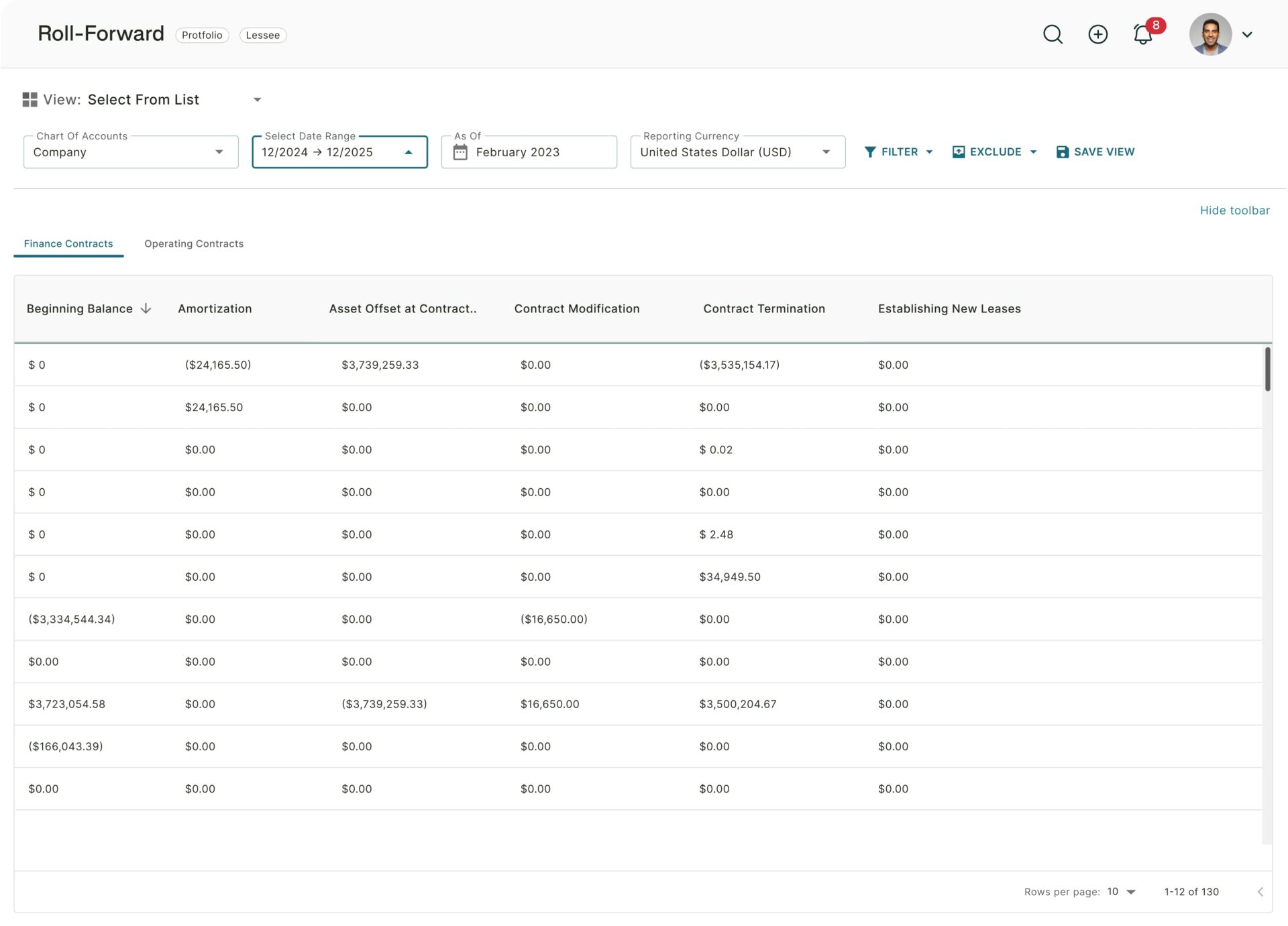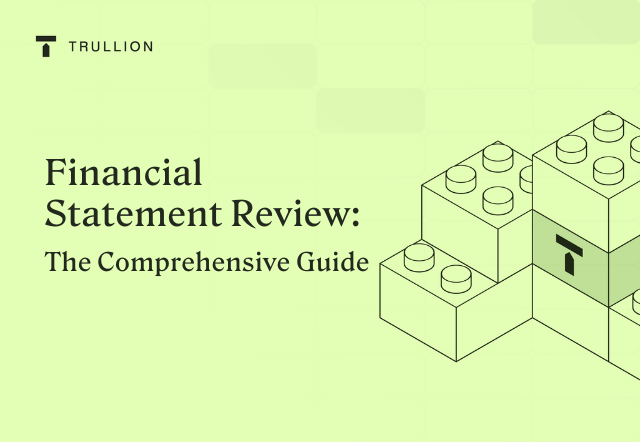When we think of accounting statements being checked by an external party, we immediately picture an audit. Audits, however, are just one type of external assurance. Another common engagement is a financial statement review.
A financial statement review has many benefits and in the right contexts can provide an elegant solution to the question of assurance.
We’ll look at financial statements reviews in general, how they differ from audits and other types of engagements, the challenges of financial statement reviews, and how to best leverage this type of review to gain maximum advantage.
What is a Financial Statement Review?
To start, let’s define a financial statement review. A financial statement review is a type of engagement conducted by an accountant to perform analytical procedures, inquiries, and other procedures to obtain a limited assurance about the financial statements. It primarily focuses on identifying any material modifications that should be made to the financial statements for them to be in conformity with the applicable financial reporting framework.
Or more officially, according to SSARS 21, the objective of a financial statement review is “to obtain limited assurance as a basis for reporting whether the accountant is aware of any material modifications that should be made to the financial statements for them to be in accordance with the applicable financial reporting framework, primarily through the performance of inquiry and analytical procedures.” (.A3 – .A8)
Unlike an audit, which provides a high level of assurance through detailed examination and verification of financial records and controls, a review is less comprehensive and does not involve an in-depth examination of every financial transaction.
The Importance and Benefits of a Financial Statement Review
A financial statement review is important for many reasons. It offers a balance between the thoroughness of an audit, and the simplicity of a compilation. Key reasons why it’s valued include:
- Enhanced credibility: A review provides assurance (albeit limited) that there are no material modifications that should be made to the financial statements for them to be in conformity with the applicable financial reporting framework. This enhances the credibility of the financial statements without the need for a full audit, which can be critical for stakeholders such as lenders, investors, and suppliers.
- Cost-effective assurance: For organizations where an audit is not required, a review presents a more cost-effective option to obtain assurance about their financial statements. It requires less time and resources than an audit, making it an attractive option when available.
- Compliance with agreements: Sometimes, loan covenants or other agreements require financial statements to be reviewed by an independent accountant. A review can satisfy these requirements without the need for a more expensive and time-consuming audit.
- Identification of significant issues: Although less comprehensive than an audit, the review process can still help in identifying significant financial issues or trends.
- Regulatory or voluntary disclosure: In some cases, a review may be conducted to meet regulatory requirements for public disclosure or for voluntary transparency initiatives. A financial statement review example, in a sense, was when several cryptocurrency-related companies voluntarily had elements of their financial statements reviewed to allay investor fears after the FTX debacle.
- Increased stakeholder confidence: By providing stakeholders with limited assurance that the financial statements do not require material modifications, a review can increase confidence among investors, creditors, and other users of the financial statements.
Financial Statement Review Cost
There’s no question that a financial statement review costs less than an audit, as generally speaking, a review is less expensive than an audit because it is less comprehensive in scope, requires fewer hours of professional work, and involves less detailed testing and verification of financial information.
The cost of a financial statement review relative to an audit can vary significantly based on a range of factors, including the size and complexity of the company, the industry in which it operates, the condition of its accounting records, and whether it’s publicly listed or privately held.
As a very rough estimate, a financial statement review might cost anywhere from 20% to 50% of the cost of an audit.
The factors influencing this include:
- Company size: Larger companies typically have more complex financial systems and transactions, which can increase the cost of both audits and reviews. However, the incremental work and depth of testing required for an audit escalate more significantly with size than for a review.
- Industry: Certain industries have specific accounting and reporting requirements that can complicate the review or audit process, potentially making the work more time-consuming and costly.
- Quality of financial records: Companies with well-organized and maintained financial records can often reduce the cost of both reviews and audits. Poorly kept records require additional time for sorting and verification, increasing costs.
- Listed vs. unlisted: Publicly listed companies may face stricter regulatory requirements for their financial reporting, which can increase the cost of audits more significantly than reviews due to the higher level of assurance and scrutiny required.
- Location and market rates: The cost of professional services, including audits and reviews, varies by geographic location and the prevailing market rates of the service providers.
Financial Reporting Standards & Requirements
The framework for providing financial statement reviews is provided by the relevant official accounting bodies. Internationally, the International Standard on Review Engagements (ISRE) 2400, “Engagements to Review Financial Statements,” issued by the International Auditing and Assurance Standards Board (IAASB) applies.
In the United States, reviews of financial statements are primarily governed by Statements on Standards for Accounting and Review Services (SSARS) issued by the American Institute of Certified Public Accountants (AICPA).
There are multiple SSARS standards that have been issued. The most relevant for our discussion however is SSARS 21, “ Statement on Standards for Accounting and Review Services: Clarification and Recodification” which effectively superseded all prior SSARS except for certain provisions. Section 90 is the part of this standard that governs financial statement reviews.
For public companies, the regulatory environment and requirements for financial statement reviews can be more stringent and complex compared to those for private companies. While the basic nature of a financial statement review – primarily involving analytical procedures and inquiries to obtain limited assurance – remains the same, public companies may face additional rules and oversight due to their obligations to protect investors and maintain market confidence.
Understanding and Issuing the Financial Statement Review Opinion
After a financial statement review, the accountant or review practitioner issues a conclusion that is fundamentally different from the opinion provided at the end of an audit. Instead of an audit opinion, which asserts a high level of assurance that the financial statements are free of material misstatement, the conclusion from a review is more limited in scope.
The conclusion of a financial statement review typically states that the accountant has not become aware of any material modifications that should be made to the financial statements for them to be in accordance with the applicable financial reporting framework. This is known as a negative assurance. It indicates that, based on the review procedures performed, which are substantially less in scope than those of an audit, nothing has come to the accountant’s attention that causes them to believe that the financial statements are not presented fairly, in all material respects, in accordance with the financial reporting framework.
The exact wording of the review report conclusion can vary depending on the standards under which the review was conducted (e.g., AICPA, or the International Auditing and Assurance Standards Board). However, the essence of the message is generally consistent: the review has not revealed any significant issues that would require adjustments to the financial statements as presented, within the limitations of the review procedures performed.
Financial Statement Review Procedures
- In-depth analysis of review procedures.
- Breakdown of review steps for specific areas.
- Additional considerations for a thorough review.
According to SSARS 21, “The accountant should design and perform analytical procedures and make inquiries and perform other procedures, as appropriate, to obtain limited assurance as a basis for reporting whether the accountant is aware of any material modifications that should be made to the financial statements in order for the statements to be in accordance with the applicable financial reporting framework.”
This should be based on the accountant’s
- Understanding of the industry
- Knowledge of the entity
- Awareness of the risk that the accountant may unknowingly fail to modify the accountant’s review report on financial statements that are materially misstated
Typically, the following procedures are performed:
- Inquiries: Asking management and others within the entity questions about the financial statements, accounting policies, and any significant transactions or events.
- Analytical procedures: Analyzing financial data by comparing it to prior periods, budgets, forecasts, or industry benchmarks to identify any unusual items or trends that might need further explanation.
- Review of accounting principles and practices: Assessing the appropriateness of the accounting policies applied and the reasonableness of significant accounting estimates made by management.
- Reading the financial statements: Ensuring that the financial statements appear to conform with the applicable financial reporting framework and checking for obvious errors.
- Review of subsequent events: Considering events or transactions occurring after the balance sheet date that might have a material effect on the financial statements.
- Review of board of directors and audit committee minutes: Reading the minutes for information relevant to the financial statements.
- Inquiries about litigation, claims, and assessments: Asking management about any current or anticipated litigation, claims, and assessments that could affect the financial statements.
- Letters of confirmation or representation: Obtaining written representations from management about the accuracy of information provided and their responsibility for the financial statements.
Addressing Material Misstatements
If material misstatements are found during a financial statement review, addressing them involves a structured approach to ensure the financial statements provide a true and fair view of the entity’s financial position and performance.
Initially, the accountant (or review practitioner) should discuss any identified misstatements with management to understand the nature of these discrepancies and the context in which they occurred. This discussion is crucial for determining whether the misstatements are due to errors or intentional misrepresentation and for assessing the impact on the financial statements.
Management is then responsible for correcting the identified material misstatements. In cases where the misstatements are corrected, the accountant will review the adjustments to ensure they appropriately address the issues identified.
However, if management refuses to correct the material misstatements, the accountant must consider the implications for the review report. Depending on the applicable financial reporting framework and professional standards, the accountant may need to modify the review conclusion to reflect the existence of uncorrected material misstatements.
This modification could take the form of a qualification or an indication that the accountant is unable to conclude on the financial statements as a whole. Additionally, if the misstatements are believed to be the result of fraud or if there are significant concerns about the entity’s ability to continue as a going concern, further disclosures may be necessary, and the accountant may have to take further action, including notifying those charged with governance or, in certain jurisdictions, regulatory bodies.
Tips for an Effective Financial Statement Review
Like an audit, a financial review can put pressure and strain on both the company being reviewed, and the reviewers themselves. Unlike an audit however, more emphasis can be placed on analytical procedures. Given this relative advantage, implementing modern technological tools is arguably the most important way to streamline the financial statement review process.
For such a review to be effective, efficient, and provide maximum benefit to all stakeholders, the following tips should be considered:
- Integrate AI-based analytical tools: Use AI-driven tools to perform more sophisticated analytical procedures. These tools can analyze large datasets to identify patterns, trends, and anomalies that might not be apparent through traditional analysis. For example, AI can help identify unusual transactions or relationships in financial data that warrant further investigation.
- Leverage machine learning for risk assessment: ML algorithms can assist in the initial risk assessment phase by analyzing historical data and learning from past audits or reviews to identify areas of higher risk. This targeted approach allows for a more focused review, concentrating efforts on the most significant areas.
- Deploy natural language processing (NLP): Utilize NLP to analyze qualitative information within the financial statements, such as the notes and management’s discussion and analysis section.
- Automate routine processes: Implement automation tools to handle routine tasks such as data collection, preparation, and some aspects of the review procedures. This frees up time for the reviewer to focus on more complex areas that require professional judgment and to delve deeper into areas identified as risks by AI and ML tools.
- Use data visualization tools: Employ data visualization software to present financial data in a more accessible and understandable format. Visualization can highlight trends, outliers, and correlations in the data that are not easily identified in tabular data, enabling more insightful analysis and discussions with management.
- Embrace cloud-based collaboration platforms: Utilize cloud-based platforms for easier access to financial data and to facilitate collaboration among the review team, especially when members are working remotely. These platforms can also offer enhanced security features for handling sensitive financial information.
- Add value through strategic insights: Beyond the traditional scope of a review, use the insights gained from advanced analytics to provide management with strategic advice. This can include identifying operational inefficiencies, areas for cost reduction, or opportunities for revenue enhancement that are revealed through the data analysis.
- Stay abreast of technological advancements: Keep updated on the latest developments in AI, ML, and data analytics technologies and their applications in financial reviews.
Trullion’s Solution
Trying to perform a financial statement review without the latest tech tools is like manually handwriting journal entries. The world of accounting has moved to a more exciting place where the latest technologies have been harnessed to provide a completely transformed experience for all parties involved.
Trullion is at the forefront of this transformation, and its robust platform provides everything required for an effective financial statement review.
Trullion empowers accounting and audit teams, leveraging today’s best data infrastructure and AI technology to:
- Automate key areas of the compilation and review process
- Eliminate errors
- Streamline communication
- See high-level accounting and compliance workflows
- Generate audit- and review-ready outputs
With Trullion in your tech stack, financial reviews almost run themselves, surfacing key insights and providing the assurance required by all stakeholders.
Conclusion
We took a comprehensive look at financial statement reviews, including their importance, benefits, and frameworks. We contrasted reviews against audits, looking at the levels of assurance, costs, and resource usage required by each one.
We took a deep look at the issues surrounding financial statement reviews, tips including the use of technology, and how to maximize the value of such a review.
To learn more about how the latest AI-powered accounting software can power your next financial review, get in touch with Trullion today.










